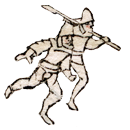History > The Battle of Morat 1476
Book recommendations for Morat 1476
All European powers were involved in the Burgundian Wars from Edward IV to Matthias Corvinus. The reception of the Burgundian Wars has been quite distinct in terms of the linguistic origin. Despite the strong contribution of Italian mercenaries and envoys, I am not aware of any important Italian book about the topic. The Italian entry about the Burgundian Wars (actually a translation from German) in the Swiss Historical Dictionary doesn't list one either. The Burgundian Wars have found their keenest reception in German, especially given the importance in defining Swiss nationalism in the 19th century, while French and English account are quite sparse.
Please also consult my personal collection of books about the Burgundian Wars at LibraryThing.com.
Books in English
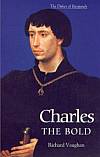 The single most important book about Morat and the Burgundian Wars remains Richard Vaughan's outstanding analytical biography of Charles the Bold, ISBN 0851159184, Boydell Press 1973:2008. To see the Burgundian soldiers in action, I recommend Gerry Embleton's sumptuous The Medieval Soldier's World 15th Century Campaign Life Recreated in Color Photographs, ISBN 1859150365, Combined Publishing 1995, as well as the Osprey MAA144 Armies of Medieval Burgundy 1364-1477, ISBN 0850455189, Osprey 1983, for its splendid Embleton illustrations. The text is unfortunately so much cribbed from Vaughan that it verges on plagiarism. The same holds true for its Swiss pendant, Osprey MAA094 The Swiss at War 1300-1500, ISBN 0850453348, Osprey 1979: wonderful Embleton illustrations, less than stellar text. This time, the issue is not plagiarism but cramming two hundred years of history into too few pages.
The single most important book about Morat and the Burgundian Wars remains Richard Vaughan's outstanding analytical biography of Charles the Bold, ISBN 0851159184, Boydell Press 1973:2008. To see the Burgundian soldiers in action, I recommend Gerry Embleton's sumptuous The Medieval Soldier's World 15th Century Campaign Life Recreated in Color Photographs, ISBN 1859150365, Combined Publishing 1995, as well as the Osprey MAA144 Armies of Medieval Burgundy 1364-1477, ISBN 0850455189, Osprey 1983, for its splendid Embleton illustrations. The text is unfortunately so much cribbed from Vaughan that it verges on plagiarism. The same holds true for its Swiss pendant, Osprey MAA094 The Swiss at War 1300-1500, ISBN 0850453348, Osprey 1979: wonderful Embleton illustrations, less than stellar text. This time, the issue is not plagiarism but cramming two hundred years of history into too few pages.
A well made specialist title and labor of love is Robert Douglas Smith and Kelly De Vries' The Artillery of the Dukes of Burgundy 1363-1477, ISBN 1843831627, Boydell Press 2005. It combines a narrative of the Burgundian military history with an illustrated catalogue of their surviving guns.
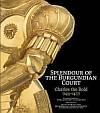 The 2009 joint exhibition about Charles the Bold by Bruges, Berne and Vienna (Which I have seen both in its Swiss and Austrian incarnation, the Swiss one being clearly superior. Vienna didn't know how to appeal to the local audience with the distant duke.) resulted in a sumptuous catalogue available in Dutch, German, French and English: Susan Marti, Till-Holger Borchert and Gabriele Keck (ed.)'s Splendour of the Burgundian Court: Charles the Bold (1433-1477), ISBN 0801448530, Cornell University Press 2009. As is typical in many modern exhibitions, it downsizes history and promotes the artistic elements. The numerous color illustrations and photos are the book's main assets.
The 2009 joint exhibition about Charles the Bold by Bruges, Berne and Vienna (Which I have seen both in its Swiss and Austrian incarnation, the Swiss one being clearly superior. Vienna didn't know how to appeal to the local audience with the distant duke.) resulted in a sumptuous catalogue available in Dutch, German, French and English: Susan Marti, Till-Holger Borchert and Gabriele Keck (ed.)'s Splendour of the Burgundian Court: Charles the Bold (1433-1477), ISBN 0801448530, Cornell University Press 2009. As is typical in many modern exhibitions, it downsizes history and promotes the artistic elements. The numerous color illustrations and photos are the book's main assets.
For amusement, Sir Walter Scott's novel Anne of Geierstein, or The Maiden of the Mist, 1829, is set during the Burgundian Wars. Two Lancastrians are tasked with a secret mission to the court of Charles the Bold. I haven't read it yet.
Books in French
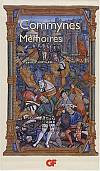 French authors tend to neglect the later part of the rivalry between Orléans and Burgundy. Compared to the attention lavished on Joan of Arc and the later Hundred Years War, the War of the Public Weal and the Burgundian Wars linger in obscurity. Bertrand Schnerb is the French go-to guy regarding the Burgundian state (with a focus on the early 15th century), e.g. among his numerous books, L'Etat bourguignon 1363-1477, ISBN 2262023603, Librairie Académique Perrin 2005. One man's work, though, remains defiant: Philippe de Commynes (1447-1511), the Flemish Macchiavelli whose memoirs (ISBN 2081203197, Flammarion 2007) present a vivid portrait of Charles the Bold, the universal spider Louis XI and their times. Unfortunately for the Burgundian Wars, Commynes had already switched sides in 1472, so his retelling of the events is based on third party knowledge and rumors.
French authors tend to neglect the later part of the rivalry between Orléans and Burgundy. Compared to the attention lavished on Joan of Arc and the later Hundred Years War, the War of the Public Weal and the Burgundian Wars linger in obscurity. Bertrand Schnerb is the French go-to guy regarding the Burgundian state (with a focus on the early 15th century), e.g. among his numerous books, L'Etat bourguignon 1363-1477, ISBN 2262023603, Librairie Académique Perrin 2005. One man's work, though, remains defiant: Philippe de Commynes (1447-1511), the Flemish Macchiavelli whose memoirs (ISBN 2081203197, Flammarion 2007) present a vivid portrait of Charles the Bold, the universal spider Louis XI and their times. Unfortunately for the Burgundian Wars, Commynes had already switched sides in 1472, so his retelling of the events is based on third party knowledge and rumors.
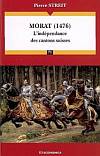 The aptly named Swiss author Pierre Streit's short account La bataille de morat 1476 - l'independance des cantons suisses, ISBN 2717856919, Economica 2009, devotes one chapter to the historical setup (10 pages) and one to the battle (12 pages), which is mostly due to the limitations of the series format, a more austere French version of an Osprey Campaign title. At the moment, it is the best introduction to the battle in French.
The aptly named Swiss author Pierre Streit's short account La bataille de morat 1476 - l'independance des cantons suisses, ISBN 2717856919, Economica 2009, devotes one chapter to the historical setup (10 pages) and one to the battle (12 pages), which is mostly due to the limitations of the series format, a more austere French version of an Osprey Campaign title. At the moment, it is the best introduction to the battle in French.
While not always reliable and often flowery in language, Paul de Vallière's Morat Le Siège Et La Bataille (1476), Lausanne Spes 1926, remains a great read in the classic military history mold. [cont.]
Books in German
The books below are divided into three groups. The first group are introductory works for the general reader. The second group are the core books, many of which were issued around the 400th and 500th anniversary of the battle. The third group encompasses recent research books.
Introductory books
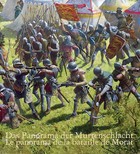 The Murten panorama was one of the highlights of Expo02, the 2002 Swiss national exhibition. To accompany and illustrate a visit to the panorama, a lavishly illustrated guidebook, Hans-Rudolf Früh (ed.) Das Panorama der Murtenschlacht, ISBN 3000094482, Stiftung Panorama, Murten 2002, was produced that offers a good introduction to the battle and to the panorama.
The Murten panorama was one of the highlights of Expo02, the 2002 Swiss national exhibition. To accompany and illustrate a visit to the panorama, a lavishly illustrated guidebook, Hans-Rudolf Früh (ed.) Das Panorama der Murtenschlacht, ISBN 3000094482, Stiftung Panorama, Murten 2002, was produced that offers a good introduction to the battle and to the panorama.
In the same vein, MILAK (Military Academy at ETH Zurich) has published a valuable booklet about the Burgundian Wars (Benjamin Geiger: Burgunderkriege, Militärgeschichte zum Anfassen 4, Bern 2003) to serve teachers and tourists in discovering the battle in the field (The booklet, costing around 20 CHF, can be ordered from Swiss administration procurement from verkauf.militaer@bbl.admin.ch).
 Some of the books recommended on the left exist also in German translation. I especially like Gerry Embleton's book whose only defect is its shortness: Gerry Embleton Söldnerleben im Mittelalter, ISBN 3613026783, Motorbuch Verlag 2006, Paul de Vallière Murten Die Belagerung und die Schlacht 1476, Lausanne Spes 1926, as well as the catalogue to the Berne/Vienna/Bruges exhibition Susan Marti, Till-Holger Borchert and Gabriele Keck (ed.) Karl der Kühne (1433-1477): Kunst, Krieg und Hofkultur, ISBN 3763025138, Belser 2008.
Some of the books recommended on the left exist also in German translation. I especially like Gerry Embleton's book whose only defect is its shortness: Gerry Embleton Söldnerleben im Mittelalter, ISBN 3613026783, Motorbuch Verlag 2006, Paul de Vallière Murten Die Belagerung und die Schlacht 1476, Lausanne Spes 1926, as well as the catalogue to the Berne/Vienna/Bruges exhibition Susan Marti, Till-Holger Borchert and Gabriele Keck (ed.) Karl der Kühne (1433-1477): Kunst, Krieg und Hofkultur, ISBN 3763025138, Belser 2008.
Core books
For the 400th anniversary of the battle of Morat in 1876, G.F. Ochsenbein collected all the original sources that he could lay hand upon. It has served as the go-to book for most writers about the battle, even if it is not always fully reliable. G.F. Ochsenbein Die Urkunden Der Belagerung Und Schlacht Von Murten, Freiburg 1876. Diebold Schilling and his nephew of the same name wrote and illustrated chronicles at the end of the 15th century which are named after the city that ordered them (Berner, Luzerner, Zürcher Chronik). These chronicles are available as expensive facsimilie, reprint editions and scanned texts.
 Florens Deuchler's Die Burgunderbeute, Stämpfli Bern 1963, contains an illustrated inventory in black and white of the surviving objects taken from Charles the Bold's camps at Grandson and Morat. An inventory of a different sort are the two books by Georges Grosjean, Der Kupferstich Martinis über die Schlacht bei Murten im Jahre 1476, Stocker Zürich 1974, and Die Schlacht bei Murten in drei altschweizerischen Chronikbildern, Stocker Zürich 1975, that examine the historical aspects of early prints and illustrations of the battle. The 500th anniversary of the battle saw the publication of a Festschrift, L.E. Roulet (ed.) Die Murtenschlacht 500-Jahr-Feier der Schlacht bei Murten, Freiburg 1976.
Florens Deuchler's Die Burgunderbeute, Stämpfli Bern 1963, contains an illustrated inventory in black and white of the surviving objects taken from Charles the Bold's camps at Grandson and Morat. An inventory of a different sort are the two books by Georges Grosjean, Der Kupferstich Martinis über die Schlacht bei Murten im Jahre 1476, Stocker Zürich 1974, and Die Schlacht bei Murten in drei altschweizerischen Chronikbildern, Stocker Zürich 1975, that examine the historical aspects of early prints and illustrations of the battle. The 500th anniversary of the battle saw the publication of a Festschrift, L.E. Roulet (ed.) Die Murtenschlacht 500-Jahr-Feier der Schlacht bei Murten, Freiburg 1976.
 A marvelous curiosity is the collection of photographs from the 1926 historical cortege, E.A. Wüthrich Feier des 450. Jahrestages der Schlacht bei Murten historischer Festzug, Zürich 1926, offering a glimpse into how the battle was commemorated at the end of the 19th to WWII.
A marvelous curiosity is the collection of photographs from the 1926 historical cortege, E.A. Wüthrich Feier des 450. Jahrestages der Schlacht bei Murten historischer Festzug, Zürich 1926, offering a glimpse into how the battle was commemorated at the end of the 19th to WWII.
Research books
Following in the footsteps of Werner Paravicini, a school of German historians examining Franco-Belgian-German relations has developed. Apart from clarifying some of the diplomatic games played by Louis XI, Charles the Bold and the Roman Emperor, its most interesting finding is the discussion of early modern nationalism and the propaganda value of chronicles: Sieber-Lehmann Spätmittelalterlicher Nationalismus die Burgunderkriege am Oberrhein und in der Eidgenossenschaft, ISBN 3525354304, Vandenhoeck + Ruprecht 1995, and Gerrit Himmelsbach Die Renaissance des Krieges Kriegsmonographien und das Bild des Krieges in der spätmittelalterlichen Chronistik am Beispiel der Burgunderkriege, ISBN 3905313170, Chronos 1999.
Two books derserve to be mentioned. Arnold Esch has mined the minutes and missives of the city of Berne, which offer a splendid coverage of events and the sausage making process: Arnold Esch Alltag der Entscheidung, Haupt Bern 1998. As far as the Swiss way of war is concerned, the doyen of Swiss military history has written the seminal and entertaining work about the topic: Walter Schaufelberger Der Alte Schweizer und sein Krieg, Europa Zürich 1966.
Written by Jean-Claude Brunner, November 2011.